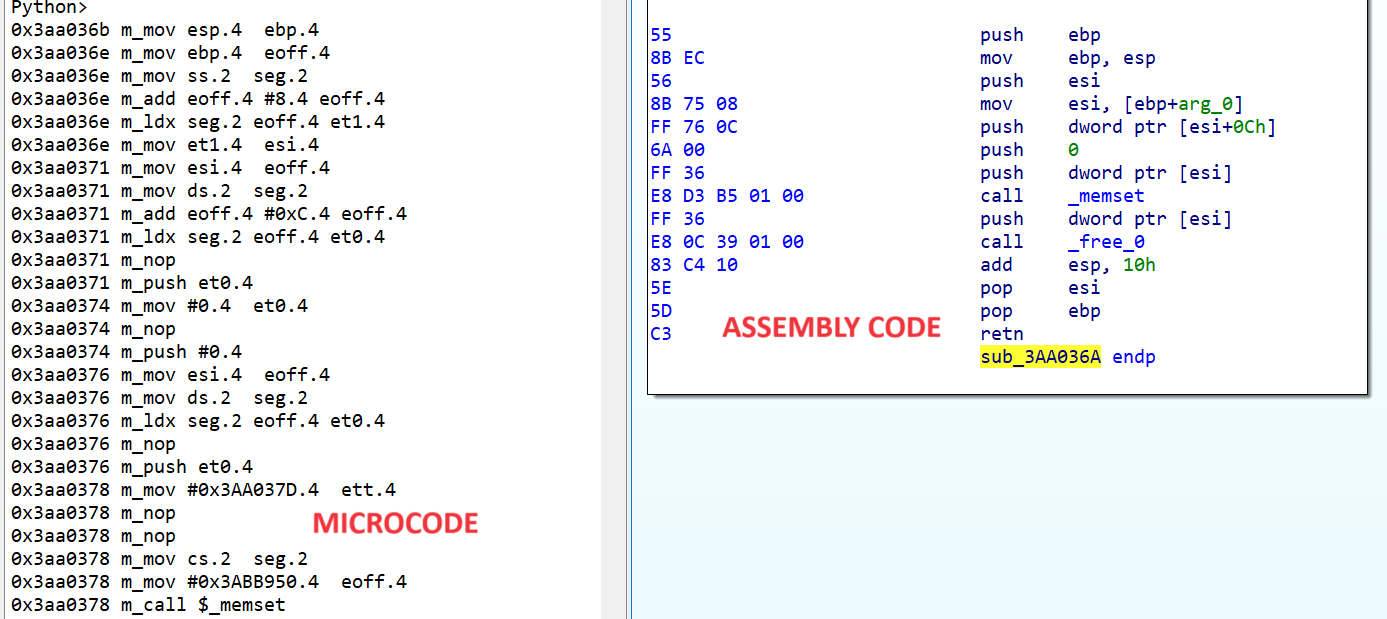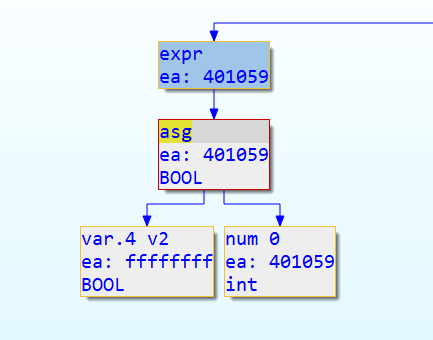Introduction
In this publication, we delve into Hex-Rays microcode and explore techniques for manipulating the generated CTree to deobfuscate and annotate decompiled code. The final section includes a practical example demonstrating how to annotate a custom import table for malware analysis.
This guide is meant to help reverse engineers and malware analysts better understand the internal structures used during IDA's function decompilation. We advise keeping an eye on the Hex-Rays SDK that can be found under IDA PRO’s plugins directory, all the structures discussed below are sourced from it.
Architecture
Hex-Rays decompiles a function through a multistage process starting with the disassembled code of a function:
-
Assembly code to microcode:
It does a conversion of the assembly instructions that are stored in aninsn_tstructure to microcode instructions represented by aminsn_tstructure -
CTree generation:
From the optimized microcode, Hex-Rays generates the Abstract Syntax Tree(AST), its nodes are either statements (cinsn_t) or expressions (cexpr_t); note that bothcinsn_tandcexpr_tinherit from thecitem_tstructure
Microcode
Microcode is an intermediate language (IL) used by Hex-Rays, generated by lifting the assembly code of a binary. This has multiple advantages, one of which is that it is processor-independent.
The following screenshot displays the assembly and decompiled code, alongside its microcode extracted using Lucid, a tool that facilitates microcode visualization.

We can access the MBA (microcode block array) through the cfunc_t structure of a decompiled function with the MBA field.
Tip: we get the cfunc_t of a decompiled function with the ida_hexrays.decompile.
mba_t is an array of micro blocks mblock_t, the first block represents the entry point of the function and the last one represents the end. Micro blocks (mblock_t) are structured in a double linked list, we can access the next / previous block with nextb/prevb fields respectively. Each mblock_t includes a double linked list of microcode instructions minsn_t, accessed by the field head for the first instruction of the block and tail for the last instruction of the block. The mblock_t structure is depicted in the following code snippet.
A microcode instruction minsn_t is a double linked list, each microcode instruction contains 3 operands: left, right, and destination. We can access the next/previous microcode instruction of the same block with next/prev fields; the opcode field is an enumeration (mcode_t) of all the microinstruction opcodes, for example, the m_mov enum represents the mov opcode.
Each operand is of type mop_t, depending on the type (accessed with the t field) it can hold registers, immediate values, and even nested microcode instructions. As an example, the following is the microcode of a function with multiple nested instructions:

The microcode generation progresses through various maturity levels, also referred to as optimization levels. The initial level, MMAT_GENERATED, involves the direct translation of assembly code into microcode. The final optimization level before generating the CTree is MMAT_LVARS.
Microcode traversal example
The following Python code is used as an example of how to traverse and print the microcode instructions of a function, it traverses the microcode generated at the first maturity level (MMAT_GENERATED).
The script's output is presented below: on the left, the printed microcode in the console, and on the right, the assembly code by IDA:

CTree
In this section, we'll dive into the core elements of Hex-Rays CTree structure, then proceed to a practical example demonstrating how to annotate a custom import table of malware that loads APIs dynamically.
For a better understanding, we will be leveraging the following plugin (hrdevhelper) that allows us to view the CTree nodes in IDA as a graph.

citem_t is an abstract class that is the base for both cinsn_t and cexpr_t, it holds common info like the address, item type and label while also featuring constants like is_expr, contains_expr that can be used to know the type of the object:
The item type accessed with the op field indicates the type of the node, expression nodes are prefixed with cot_ and the statements nodes are prefixed with cit_, example cot_asg indicates that the node is an assignment expression while cit_if indicates that the node is a condition (if) statement.
Depending on the type of the statement node, a cinsn_t can have a different attribute for example if the item type is cit_if we can access the detail of the condition node through the cif field, as seen in the below snippet, cinsn_t is implemented using a union. Note that a cblock_t is a block statement which is a list of cinsn_t statements, we can find this type for example at the beginning of a function or after a conditional statement.
In the example below, the condition node of type cit_if has two child nodes: the left one is of type cit_block which represents the "True" branch and the right is the condition to evaluate, which is a call to a function, a third child is missing as the condition does not have a "False" branch.
The following is a graph showcasing the statement node cit_if

Find the associated decompilation for the above CTree:

The same logic applies to expressions nodes cexpr_t, depending on the node type, different attributes are available, as an example, a node of type cot_asg has children nodes accessible with the fields x and y.

Finally the cfunc_t structure holds information related to the decompiled function, the function address, the microcode block array, and the CTree accessed with the entry_ea, mba and body fields respectively.
CTree traversal example
The provided Python code serves as a mini recursive visitor of a CTree, note that it does not handle all node types, the last section will describe how to use the Hex-Rays built-in visitor class ctree_visitor_t. To begin, we obtain the cfunc of the function using ida_hexrays.decompile and access its CTree via the body field.
Next, we check if the node(item) is an expression or a statement. Finally, we can parse the type through the op field and explore its child nodes.
Displayed below is the output of the traversal script executed on the start function of a BLISTER sample:

Practical example: annotating the custom import table of a malware sample
Now that we've gained insights into the architecture and structures of the generated CTree, let's delve into a practical application and explore how to automate the annotation of a custom import table of malware.

Hex-Rays provides a utility class ctree_visitor_t that can be used to traverse and modify the CTree, two important virtual methods to know are:
visit_insn: to visit a statementvisit_expr: to visit an expression
For this example, the same BLISTER sample is used; after locating the function that gets Windows APIs addresses by hash at address 0x7FF8CC3B0926(in the .rsrc section), adding the enumeration to the IDB and applying the enum type to its parameter, we create a class that inherits from ctree_visitor_t, as we are interested in expressions, we will be overriding visit_expr only.

The idea is to locate a cot_call node(1) of the function that resolves APIs by passing the obj_ea address of node’s first child to the function idc.get_name which will return the function name.
Next retrieve the enum of the hash by accessing the right parameter of the call node(2), in our case parameter 3.
The next step is to locate the variable that has been assigned the address value of the WinAPI function. To do that we first need to locate the cot_asg node(3), parent of the call node by using the find_parent_of method under cfunc.body of the decompiled function.
Finally, we can access the first child node(4) under the cot_asg node, which is of type cot_var and get the current variable name, the Hex-Rays API ida_hexrays.rename_lvar is used to rename the new variable with the Windows API name taken from the enum parameter.
This process can ultimately save a significant amount of time for an analyst. Instead of spending time on relabeling variables, they can direct their attention to the core functionality. An understanding of how CTrees work can contribute to the development of more effective plugins, enabling the handling of more complex obfuscations.
For a complete understanding and context of the example, please find the entire code below:
Conclusion
Concluding our exploration into Hex-Rays microcode and CTree generation, we've gained practical techniques for navigating the complexities of malware obfuscation. The ability to modify Hex-Rays pseudo code allows us to cut through obfuscation like Control Flow Obfuscation, remove dead code, and many more. The Hex-Rays C++ SDK emerges as a valuable resource, offering well-documented guidance for future reference.
We hope that this guide will be helpful to fellow researchers and any avid learner, please find all the scripts in our research repository.
